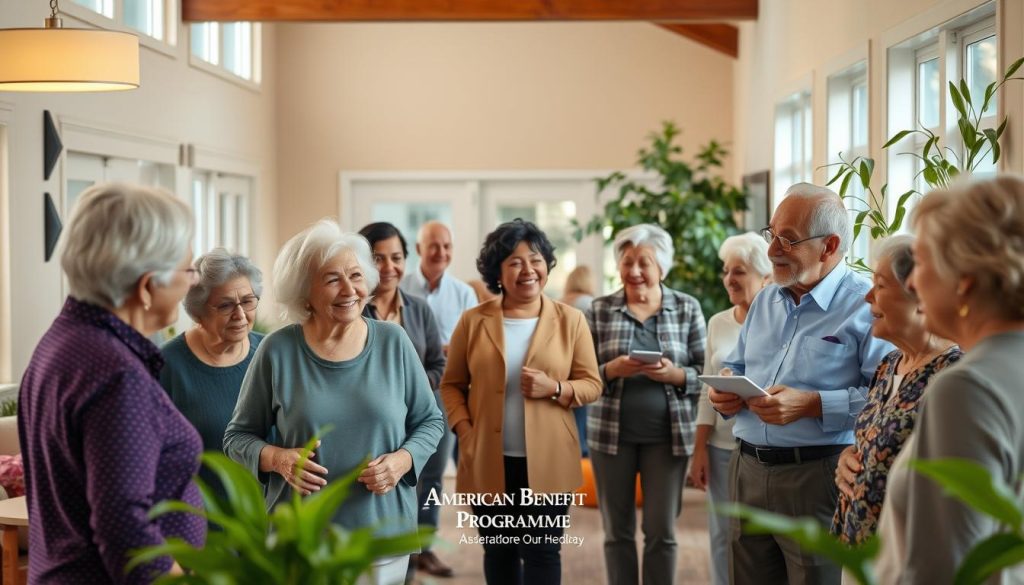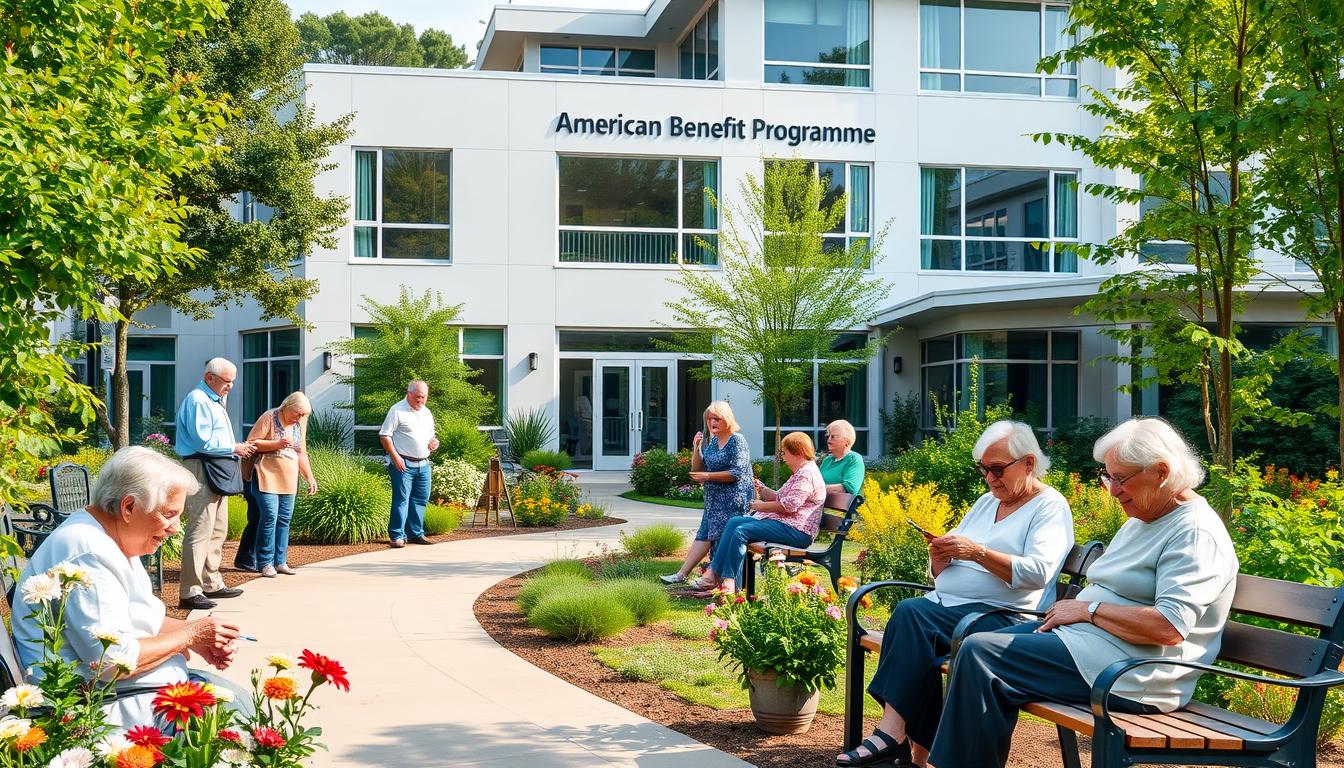Do you know what an assisted living facility provides besides a place to live? Families looking for senior care need to check out many elder care services. These places help seniors with daily tasks but let them stay independent. This includes seniors with Alzheimer’s and other dementias1. This guide will help you understand how to pick the best assisted living place. We will talk about checking personal needs, costs, and rights of residents. This will help you make a smart choice.
Key Takeaways
- Assisted living fills the gap between home care and nursing homes, giving needed support without 24/7 nursing.
- Mostly, it’s for seniors who need help with daily tasks, ensuring they keep their freedom and dignity.
- They offer personal care, help with health care, and fun activities that fit each person’s likes.
- The place’s location and look greatly affect how happy and well residents feel.
- Knowing all about costs, contracts, and rights of residents makes for a sure and well-informed choice.
Understanding Assisted Living
Assisted living communities help seniors who want to be a bit independent. They help with daily needs while offering a community feel. Services include meals, cleaning, and personal care. Unlike nursing homes, they focus less on medical care. They aim to boost independence.
Defining Assisted Living Facilities
These places can home 25 to more than 100 residents. They help with daily activities like dressing and eating. American Benefit Programme2 says they adapt to many care needs. Most seek companionship and a little help. They mix social life with some freedom.
Differences Between Assisted Living and Nursing Homes
Assisted living boosts independence; nursing homes offer full medical care. The U.S. had more assisted living places than nursing homes in 2012. This shows many prefer the lighter care of assisted living. It suits those not needing intense medical help.
Assessing Individual Needs
Choosing the right assisted living place begins by checking what the person needs. This step makes sure people get the right help for their needs. Before moving in, staff figure out what kind of help someone needs. This ensures they find the best long-term home3.
Evaluating Levels of Care Required
Different things are looked at to understand care needs. Places like HarborChase of Naples offer care from Basic to Level 3 for lots of support4. They look at daily living tasks, long-term sicknesses, medicine, and if someone can move around easily. They talk to the person and their care team to know exactly what is needed4.
Considering Personal Preferences and Lifestyle
What a person likes is also important in finding care. Most people over 65 will need some long-term help. It’s key to think about how they want to live and the place’s vibe5. They look at if someone is social, what makes them feel safe, and how they want to live. They make sure the place fits what each person wants5.
Services Offered in Assisted Living Facilities
Assisted living places help people live better every day. They offer many services that help residents stay independent and make friends.
Personal Care Services
In assisted living places, personal care is a big deal. People get help with things like bathing, dressing, and taking medicine. This helps them live well. Caregivers are there all day and night to help. They also do laundry and clean, making life comfy67.
Healthcare Support and Coordination
Health care is key in assisted living. Nurses are there all the time to care for everyone8. They help schedule doctor visits and offer special health programs. This helps residents stay healthy. Every resident has an emergency call system for safety and peace of mind7. Good health care means residents get their medicine right and are checked often.
Recreational Activities and Dining Options
Fun activities are important for health. Assisted living places offer lots of social activities, exercise, and wellness programs7. They serve three meals a day in a place where everyone can eat together. This helps residents make friends during meals. They also make special meals for those who need them8.
The Importance of Location
Finding the best place for assisted living is key to improving life quality. Being close to family and doctors is important. It helps seniors stay connected and get medical help quickly. This is very important for those with ongoing health issues who need regular care9.
Proximity to Family and Healthcare Providers
Being near family helps make strong relationships. This can make residents happier and improve their mental health. Living close to hospitals gives peace of mind to both the elderly and their families9.
Accessibility and Community Resources
It’s important to choose a place that’s easy to get around. The social activities and services available can really affect how residents live. If a facility feels like part of the community, it can offer more things to do like going to the gym, borrowing books from the library, or eating out10
| Feature | Importance |
|---|---|
| Proximity to Family | Enhances social interaction and emotional support |
| Access to Healthcare | Ensures timely medical intervention for seniors |
| Community Amenities | Contributes to overall well-being and satisfaction |
| Accessibility | Facilitates easier movement and independence for residents |
Having good access and community features is key. It helps create a lively and caring place to live11.
Researching Potential Assisted Living Facilities
Start looking for the right assisted living place by doing deep research. You can learn a lot and see many options by checking out different sources. It’s good to use the internet and ask people who know a lot about this.
Using Online Directories and Resources
Web directories are very helpful when checking out assisted living spots. Sites like A Place for Mom and SeniorAdvisor have lots of reviews and info. They list about 28,900 places in the U.S., giving you many choices12. They also tell you the average cost is $5,551 a month in 2024. But, prices change based on where you are and what services they offer13.
By using these websites, picking the right place becomes easier. They show you how clean the place is, the kind of help they give, and more.
Seeking Recommendations from Healthcare Professionals
Asking for advice from health experts is a smart move. Insights from family, friends, and coworkers are really precious. About 83% of people believe in such advice for services like assisted living12. Doctors and nurses often know about the best places for great care.
When you add this to your web research, it helps to narrow your choices. It makes sure the places you’re looking at have top-notch care for elders.
Visiting Assisted Living Communities
Visiting assisted living places helps you see what they’re like. Look around at shared spaces to see if they’re clean. Clean places mean a nicer home for everyone14. Watch how people living there and the staff talk to each other. This shows if people are happy.
Assessing Cleanliness and Atmosphere
Check for safety stuff like handrails. They keep everyone safe and comfy14. Clean rooms and eating spots make life better.
Evaluating Staff Interaction and Resident Satisfaction
Seeing how staff talk to people living there tells you about the care. Enough staff means everyone gets good attention15. But, too many new staff might be a worry14. Talking to the staff lets you ask about care and if there are nurses14.
Seeing these places yourself helps you choose the best spot for family. Seeing if there are fun activities and nice things to do matters. This makes sure they’ll be happy.

Understanding Costs and Contracts
It’s important to know about the money part of assisted living for families looking at these choices. The first base fees, covering things like utilities and cleaning, change a lot by place and room type. These fees show the living area and the included features and services. When looking at the total assisted living costs, other care services needed monthly can make costs go up a lot.
Base Fees and Additional Charges
Most places have different price levels based on the care a person needs. For help with everyday things, costs can go from hundreds to thousands a month16. Know that extra fees for special services like handling medicines may add up fast. Many homes also ask for fees upfront, like deposit fees, with little chance to get money back16.
Insurance and Financial Options
Insurance and financial options are very important for planning assisted living. Long-term care insurance helps pay for these costs, giving families some money relief16. Medicaid helps those who qualify, but knowing if a place is approved is key because it affects coverage a lot. Medicare doesn’t pay for assisted living, only care from skilled nurses when needed16. Reading contracts well, especially about ending terms or being asked to leave, is good17.
Looking over contracts well before signing is smart. It helps understand and find any future problems. Planning lets families talk about rising living costs in contracts. It makes sure the place fits their care needs as things change17.
Residents’ Rights and Expectations
People living in care homes have certain rights. These rights help them feel respected and free. They help make a caring and supportive place for both them and their families. Care homes must respect these assisted living rights. Families should talk about their staff expectations to keep things nice and respectful.
Understanding Personal Rights in Assisted Living
The 1987 Nursing Home Reform Law helps protect personal rights in assisted living18. This means everyone gets treated the same and can join in activities. Residents can handle their money and make personal choices19. They also get to keep their things and have their privacy. Care homes must tell residents about their health. This lets residents help make choices about their care19.
Expectations for Staff Interaction and Care
Families should be clear about what they expect from staff. It’s important that staff talk nicely and support the residents well. Care homes need to tell families if anything changes with their loved one. This is so families always know what’s happening19. Residents deserve a safe and private place to live. They should feel free to make their own choices18.
| Rights of Residents | Expectations from Staff |
|---|---|
| Right to manage personal finances | Provide transparent communication |
| Right to privacy and personal belongings | Respect individual choices and autonomy |
| Right to participate in care decisions | Offer prompt notifications of changes |
| Right to refuse visits | Ensure respectful interactions |
Understanding these rights makes a place where people feel respected and important19. It builds good relationships between the residents and staff. Following these rules makes living in assisted care places better for everyone.
Monitoring and Adjusting Care Needs
Senior care facilities work hard to give the right support. They check on residents often to keep them well. By monitoring care needs, they can change care plans when needed. This keeps care top-notch as elders’ health changes. Places like Central Scottsdale Assisted Living keep a close eye on health. They do full health checks and think about what each person needs20.
Regular Assessments of Care Requirements
It’s important to always check on care needs. Places need to look at all parts of care, like health, food, and mind. They use cool tech to watch health closely. This helps them change care plans fast. It helps people feel more free and part of the community20. Westmont of Cypress makes care plans just for you. They make sure you get all the care you need21.
Encouraging Family Involvement in Care Plan Updates
Family involvement in care plans makes care better. Places like Westmont of Cypress work with families. They listen to what families say about care. This helps everyone talk better about care. Families know what’s going on. This makes everyone trust and like the care more21.
| Facility | Approach to Monitoring | Family Engagement |
|---|---|---|
| Central Scottsdale Assisted Living | Routine health monitoring and comprehensive assessments | Encourages open communication |
| Westmont of Cypress | Personalized care plans and regular evaluations | Involves families in decision-making |
Transitioning to an Assisted Living Facility
Moving to assisted living is a big change. Getting ready is key to a smooth shift. Knowing a few things can help everyone feel better about this move.
Preparing for the Move
First, think about what to take along. Big furniture might not fit in the new, smaller space22. Going through belongings can be tough. It helps to have family and friends pack with you22. It’s good to know what the place suggests you bring before moving22.
Supporting Residents During the Adjustment Period
The time after moving can feel hard. People might feel stressed or sad at first22. Being there to listen and support is really important. Joining in events and making friends helps with getting used to the new place22.
It’s better for family to support rather than decide for the resident22. Talking to friends or a pastor can also comfort the person moving22. Staying hopeful and patient makes a big difference in their adjustment.

Looking at these key moving and adjusting steps can make the journey smoother.
For more advice on moving to assisted living, see this detailed guide22.
Conclusion
Choosing the right assisted living is key for our loved ones’ happiness as they get older. With the number of people over 65 expected to hit 1.5 billion by 2050, we need good care solutions. These should help them live well and stay independent23. By looking at what each person needs, learning what services exist, and talking openly with the staff, families can make better choices.
Studies show that seniors in assisted living often go to the hospital more and have more health issues than those who live on their own24. So, think about what makes your loved one happy and their way of life. This can lead to finding a community that boosts their spirit. Tools that measure quality of life can also point families to the right place for their loved ones.
Finding an assisted living community can seem hard, but a clear plan can make it easier. This way, seniors can live in a place where they feel cared for yet remain free. It’s important to keep checking and making changes to make sure they have the best experience in their new home23.
Source Links
- Planning Ahead: A Consumer’s Guide to Nursing Facilities
- Long-Term Care Facilities: Assisted Living, Nursing Homes, and Other Residential Care
- Understanding Senior Living Assessments | Where You Live Matters
- Needs Assessment: The First Step When Moving to Senior Housing
- Needs Assessment: A Guide to Understanding Senior Care
- What Does Assisted Living Provide for Residents?
- Assisted Living Facilities – HelpGuide.org
- Do Assisted Living Communities Provide Medical Care Services?
- Role of Location in Choosing Assisted Living
- The Importance of a Florida Senior Living Facility – South Coast Improvement Company
- Why Location Matters | The Ridge Senior Living
- How to Research Assisted Living Facilities – Research Checklist
- A 2024 Guide to Finding an Assisted Living Community
- Questions to Ask Assisted Living Facilities When Touring
- Visiting an Assisted Living Facility: A Checklist – Freedom Pointe
- The Cost of Assisted Living: What You Need to Know
- Assisted Living Resident Contracts: What You Need To Know
- National Consumer Voice
- Your Resident Rights and Protections
- Wellness Checks and Routine Health Monitoring in Senior Communities
- Monitoring Care Quality in Assisted Living – Westmont Living
- Quality of life in assisted living facilities for seniors: A descriptive exploratory study
- Health Outcomes From Assisted Living Facilities: A Cohort Study of a Primary Care Practice

Leave a Reply